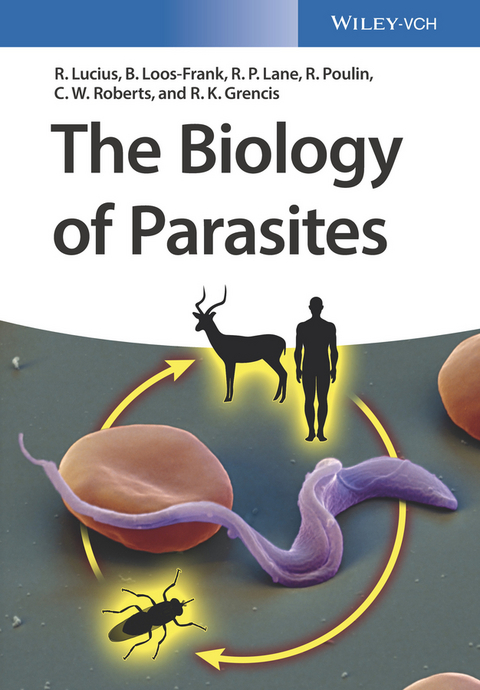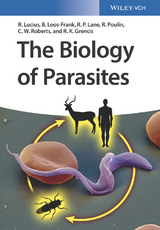The Biology of Parasites
Wiley-VCH (Verlag)
978-3-527-32848-2 (ISBN)
Immunological aspects are covered in detail and 250 study questions with solutions are included for self-study.
Based on a successful German textbook, this edition has been completely rewritten and restructured with the help of outstanding researchers and lecturers from the UK and New Zealand, making it the first choice for those parasitology students planning to stay in research in academia or industry.
Endlich ein Lehrbuch, das die neuesten Erkenntnisse über die Zell- und Molekularbiologie von Parasiten präsentiert. Jede Klasse von Parasiten bei Tieren sowie die wichtigsten Parasiten beim Menschen werden behandelt. Für Studenten, die in der wissenschaftlichen oder industriellen Forschung arbeiten möchten, ein absolutes Muss.
Richard Lucius heads the department of Molecular Parasitology at Humboldt-Universität zu Berlin (Germany). His work concentrates on the interaction between parasites and their host`s immune system. He is bearer of the Leuckart medal of the German Society of Parasitology and of the Behring-Bilharz medal.
Brigitte Frank is emeritus Professor for Parasitology at Universität Hohenheim (Germany). Since the 1990s, she has studied the life cycles of Dicrocoelium dendriticum and other trematodes as well as of cestodes of the genus Mesocestoides and Taenia. She has also worked on the biology of lung mites and other arthropod mammalian parasites.
Robert Poulin is Professor of Zoology at the University of Otago (New Zealand). His research group focuses on broad questions in parasite ecology and evolution. He was awarded the Hutton Medal from the Royal Society of New Zealand and the Wardle Medal from the Canadian Society of Zoologists for his outstanding contribution to parasitology.
Craig W. Roberts is Professor of Parasitology at the University of Strathclyde, Glasgow (UK). His current research concentrates on (i) the interaction of Toxoplasma gondii and Acanthamoeba with their host and how this knowledge can be exploited for vaccines design and new antimicrobials and (ii) the influence of sex and pregnancy associated hormones on immunity.
Richard Grencis is Professor of Immunology at the University of Manchester (UK). His research has focused on immune responses to parasites, especially intestinal nematodes. He was awarded the Wright Medal from the British Society for Parasitology for his outstanding contribution to Parasitology and he serves as co-editor-in-chief of the journal Parasite Immunology.
Richard Lane was formerly Director of Science at the Natural History Museum, London (UK). As a medical entomologist he studied the transmission of several insect-borne diseases, especially leishmanaisis. He has also been Head of the Vector Biology Unit at the London School of Hygiene and Tropical Medicine and Head of International Health at the Wellcome Trust.
Table of Contents: Biology of Parasites
Part I General Parasitology
1. General aspects of parasite biology
1. 1. The world of terms in parasitology
1. 1. 1. The term "Parasite"
1. 1. 2. Modes of coexistance of animals of different species
1. 1. 3. The different forms of parasitism
1. 1. 4. Parasites and hosts
1. 1. 5. Modes of ransmission
Teaching questions
1. 2. What is unique about parasites?
1. 2. 1. A very peculiar habitat: The host
1. 2. 2. Specific morphological and physiological adaptations
1. 2. 3. Flexible strategies of reproduction
Teaching questions
1. 3. The burden by parasites on host individuals and host populations
Teaching questions
1. 4. Parasite/host coevolution
1. 4. 1. The main features of coevolution
1. 4. 2. The role of alleles in coevolution
1. 4. 3. Rareness is an advantage
1. 4. 4. Malaria as an example for coevolution
Teaching questions
1. 5. The influence of parasites on mate choice
Teaching questions
1. 6. Immunobiology of parasites
1. 6. 1. Defence mechanisms of hosts
1. 6. 2. Immune evasion
1. 6. 3. Parasites as opportunistic pathogens
1. 6. 4. Anti parasite vaccines
1. 6. 5. The Hygiene Hypothesis: Do parasites have a good side?
Teaching questions
1. 7. How Parasites alter their hosts
1. 7. 1. Alterations of host cells
1. 7. 2. Intrusion of the hormonal systems
1. 7. 3. Changing the behavior of hosts
Teaching questions
Part II Parasitic protozoa
2. Biology of parasitic protozoa
2. 1. Microspora
Teaching questions
2. 2. Metamonada
Teaching questions
2. 3. Parabasala
Teaching questions
2. 4. Amoebaozoa
Teaching questions
2. 5. Euglenozoa
Teaching questions
2. 6. Percolozoa
Teaching questions
2. 7. Stramenopila
Teaching questions
2. 8. Alveolata
2. 8. 1. Apicomplexa
2. 8. 1. 1. Gregarinea
2. 8. 1. 2. Coccidea
2. 8. 1. 3. Haematozoea
2. 8. 2. Ciliophora
Teaching questions
2. 9. Myxozoa
Teaching questions
Part III Helminths
3. Platyhelmintha
3. 1. Trematoda
3. 1. 1. Aspidogastrea
3. 1. 2. Digenea
Teaching questions
3. 2. "Monogenea"
3. 3. Cestoda
3. 3. 1. Gyrocotyloidea
3. 3. 2. Amphilinidea
3. 3. 3. Eucestoda
3. 3. 3. 1. Caryophyllidea
3. 3. 3. 2. Diphyllobothriidea
3. 3. 3. 3. Mesocestoididae
3. 3. 3. 4. Cyclophyllidea
Teaching questions
4. Acanthocephala
Teaching questions
5. Hirudinea
Teaching questions
6. Nematoda
6. 1. Enoplea
6. 1. 1. Dorylaimia
6. 2. Chromadorea
6. 2. 1. Spirurina
6. 2. 2. Tylenchina
6. 2. 3. Rhabditina
Teaching questions
7. Nematomorpha
Teaching questions
Part IV Arthropoda
8. Acari
8. 1. Mesostigmata
8. 2. Metastigmata
8. 2. 1. Ixodidae
8. 2. 2. Argasidae
8. 3. Cryptostigmata
8. 4. Prostigmata
8. 5. Astigmata
Teaching questions
9. Crustacea and Pentastomida
9. 1. Crustacea
9. 2. Pentastomida
Teaching questions
10. Insecta
10. 1. Phthiraptera
10. 1. 1. "Mallophagen"
10. 1. 2. Phynchophtherina
10. 1. 3. Anoplura
10. 2 Heteroptera
10. 2. 1. Reduviidae
10. 2. 2. Cimicidae
10. 2. 3. Polyctenidae
10. 3 Siphonaptera
10. 4 Diptera
10. 4. 1. Nematocera
10. 4. 1. 1. Ceratopogonidae
10. 4. 1. 2. Culicidae
10. 4. 1. 3. Simuliidae
10. 4. 1. 4. Phlebotomidae
10. 4. 2. Brachycera
10. 4. 2. 1. Tabanidae
10. 4. 2. 2. Glossinidae
10. 4. 2. 3. Hippoboscidae
10. 4. 2. 4 .Nycteribiidae, Streblidae
10. 4. 2. 5. Muscidae
10. 4. 2. 6. Calliphoridae
10. 4. 2. 7. Sarcophagidae
10. 4. 2. 8. Oestridae
Teaching questions
Answers to teaching questions
Alphabetical index
| Erscheint lt. Verlag | 22.2.2017 |
|---|---|
| Übersetzer | Ron Shankland, Renate FitzRoy |
| Verlagsort | Berlin |
| Sprache | englisch |
| Maße | 170 x 244 mm |
| Gewicht | 1146 g |
| Einbandart | gebunden |
| Themenwelt | Medizin / Pharmazie ► Medizinische Fachgebiete |
| Studium ► Querschnittsbereiche ► Infektiologie / Immunologie | |
| Naturwissenschaften ► Biologie ► Mikrobiologie / Immunologie | |
| Veterinärmedizin ► Klinische Fächer ► Parasitologie | |
| Schlagworte | Biowissenschaften • infectious disease • Infektionskrankheiten • Life Sciences • Medical Science • Medizin • Molekularbiologie • Parasit • Parasiten • Parasitologie • Parasitology • Veterinärmedizin / Mikrobiologie,Parasitologie,Inf • Veterinary Medicine • Veterinary Microbiology, Parasitology,Infectious Diseases & Immunology • Veterinärmedizin • Veterinärmedizinische Mikrobiologie • Veterinärmedizin / Mikrobiologie,Parasitologie,Infektionen,Immunologie • Zellbiologie |
| ISBN-10 | 3-527-32848-3 / 3527328483 |
| ISBN-13 | 978-3-527-32848-2 / 9783527328482 |
| Zustand | Neuware |
| Informationen gemäß Produktsicherheitsverordnung (GPSR) | |
| Haben Sie eine Frage zum Produkt? |
aus dem Bereich




